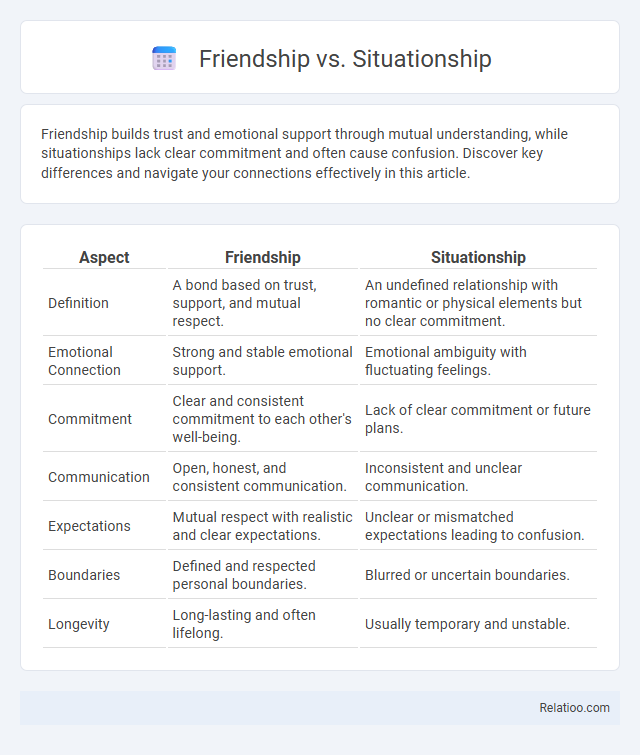Friendship builds trust and emotional support through mutual understanding, while situationships lack clear commitment and often cause confusion. Discover key differences and navigate your connections effectively in this article.
Table of Comparison
| Aspect | Friendship | Situationship |
|---|---|---|
| Definition | A bond based on trust, support, and mutual respect. | An undefined relationship with romantic or physical elements but no clear commitment. |
| Emotional Connection | Strong and stable emotional support. | Emotional ambiguity with fluctuating feelings. |
| Commitment | Clear and consistent commitment to each other's well-being. | Lack of clear commitment or future plans. |
| Communication | Open, honest, and consistent communication. | Inconsistent and unclear communication. |
| Expectations | Mutual respect with realistic and clear expectations. | Unclear or mismatched expectations leading to confusion. |
| Boundaries | Defined and respected personal boundaries. | Blurred or uncertain boundaries. |
| Longevity | Long-lasting and often lifelong. | Usually temporary and unstable. |
Understanding Friendship: Definition and Characteristics
Friendship is a mutually supportive relationship characterized by trust, empathy, and consistent communication, distinguishing it from situationships marked by ambiguity and emotional inconsistency or stagnation defined by lack of growth and connection. Understanding friendship involves recognizing its foundation in genuine care and reciprocal emotional investment, which promotes personal growth and meaningful bonds. Your social well-being thrives when you nurture friendships that offer stability and positive engagement, avoiding the confusion of undefined relational dynamics or emotional inertia.
What is a Situationship? Key Features
A situationship is a romantic or emotional connection between two people that lacks clear definition or commitment, often existing in a gray area between friendship and a formal relationship. Key features include ambiguity in status, inconsistent communication, and an absence of long-term planning or exclusivity. You may find yourself confused by mixed signals and uncertain expectations, making it important to clarify intentions to avoid emotional stagnation.
Emotional Depth: Friendship vs Situationship
Friendship offers a stable foundation of emotional depth characterized by trust, mutual understanding, and consistent support without romantic expectations. Situationships blur emotional clarity, often marked by uncertainty, fluctuating commitment, and ambiguous boundaries, which can hinder genuine emotional connection. Emotional stagnation occurs when neither friendship nor clear relational progression fosters growth, leaving feelings unresolved and personal development stalled.
Communication Styles in Friendship and Situationship
Effective communication in friendship is characterized by openness, trust, and mutual support, fostering emotional intimacy and clarity. In a situationship, communication tends to be ambiguous, sporadic, or indirect, often leading to confusion and unexpressed expectations. Understanding your communication style helps distinguish genuine connection from emotional stagnation, enabling healthier relationship dynamics.
Boundaries and Expectations: Clear or Confused?
Friendship often thrives on clear boundaries and mutual expectations, ensuring trust and respect between parties. Situationships blur these lines, leaving boundaries and expectations confused, which can lead to emotional uncertainty and miscommunication. Your well-being depends on recognizing these differences to maintain healthy connections and avoid stagnation in ambiguous relationships.
Trust and Reliability: Who Stands the Test?
Trust and reliability form the foundation that distinguishes friendship, situationship, and stagnation, with true friendship consistently standing the test of time through unwavering support and honest communication. Situationships often lack the reliability needed for long-term trust, leaving your emotions in uncertainty and vulnerability. Stagnation traps relationships in a state of inactivity, eroding trust and preventing growth, ultimately making it impossible for trust or reliability to flourish.
Longevity: Which Lasts Longer?
Friendship generally lasts longer than situationships or stagnation because it is built on trust, mutual respect, and consistent emotional support, which fosters enduring bonds over time. Situationships, often characterized by ambiguity and lack of commitment, tend to be short-lived due to unclear expectations and emotional instability. Stagnation, marked by lack of growth or progress in any type of relationship, risks fading out quickly as it fails to engage your needs or evolve meaningfully.
Emotional Impact: Fulfillment vs Uncertainty
Friendship provides emotional fulfillment through trust, support, and genuine connection, fostering stability and happiness. Situationships generate emotional uncertainty due to unclear boundaries and inconsistent communication, often leading to confusion and anxiety. Stagnation traps individuals in emotional limbo, causing frustration and a lack of growth, which can negatively affect mental well-being.
Navigating Transitions: From Situationship to Friendship (or Vice Versa)
Navigating transitions between situationship and friendship requires clear communication and mutual understanding of boundaries and expectations. Recognizing emotional needs and respecting individual growth facilitates healthy development or amicable redefinition of the relationship. Prioritizing transparency helps avoid stagnation, ensuring the connection evolves rather than remains unclear or unproductive.
Choosing What’s Best for You: Friendship or Situationship
Evaluating the dynamics of friendship versus situationship requires recognizing the emotional investment and long-term benefits each offers; friendships foster trust, stability, and mutual support, while situationships often involve ambiguity and limited commitment. Prioritizing personal well-being means assessing whether clarity and emotional growth found in friendships outweigh the temporary connection that situationships provide. Understanding these distinctions empowers you to select relationships aligning with your values and future goals, avoiding the stagnation that comes from indecision or unfulfilled expectations.

Infographic: Friendship vs Situationship
 relatioo.com
relatioo.com